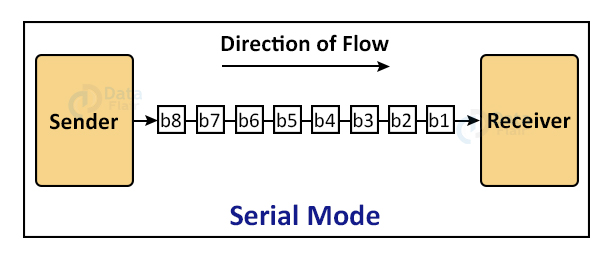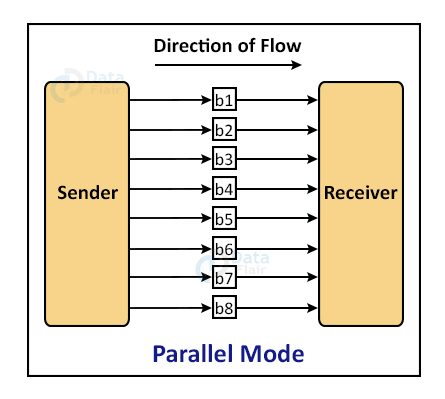Transmission Modes in Computer Networks
FREE Online Courses: Your Passport to Excellence - Start Now
Transmission modes refer to the method through which data is sent from one device to another. Transmission mode is sometimes referred to as communication mode. Each communication channel has a direction, which the transmission media provides. As a result, we also refer to the transmission mode as directional mode.
The physical layer specifies the transmission method.
Types of Transmission Modes (based on direction of data exchange):
1. Simplex Data transmission:
- Communication in Simplex mode is unidirectional.
- On a connection, only one of the two devices can send, while the other can only receive.
- The simplex mode can utilize the whole channel capacity to deliver data in only one direction.
- This form of transmission is not widely used since most connections involve the flow of data in both directions. The simplex mode finds its use in commercial applications such as sales that do not require a corresponding response.
- The radio station is a simplex channel since it sends the signal but never permits listeners to communicate back.
- As an example, consider a keyboard and conventional displays. The keyboard can only provide input, whereas the display can only provide output.
Advantages:
- During data transfer, it makes complete use of the communication channel’s capacity.
- Because the data only goes in one way, it has the fewest or no data traffic concerns.
Disadvantages:
- Unfortunately, there is no way to return information to its original source (No mechanism for acknowledgement).
- As a result, there is no communication between devices.
2. Half-Duplex Transmission:
- Each station can broadcast and receive in half-duplex mode, but not at the same time.
- When one device sends, the other device can only receive, and vice versa.
- The half-duplex mode is used when communication in both directions is not required at the same time. Each direction can use the whole capacity of the channel.
- In half-duplex mode, error detection is available, and if an error occurs, the receiver asks the sender to re-transmit the data.
- Example: Transmission of messages in a walkie-talkie happens one at a time and in both directions.
Advantages:
- During data transmission, both devices can send and receive data in the half-duplex mode, which allows them to use the whole bandwidth of the communication channel.
Disadvantages:
- Due to the fact that one device must wait while the other sends data in half-duplex mode, the data is delayed.
3. Full-Duplex Transmission:
- In full-duplex mode, both stations can broadcast and receive data at the same time.
- In full-duplex mode, signals travelling in one direction and the signals travelling in the other direction are transmitted on the same link.
- This sharing can occur in two ways:
- One route is used for sending, and one for receiving. Both are kept separate.
- Alternatively, the capacity is shared by signals travelling in both directions.
- When communication in both directions is necessary all of the time, full-duplex mode is utilised. The channel’s capacity, on the other hand, must be shared between the two directions.
- Example: A telephone network allows two people to communicate over a phone line, which allows both people to talk and listen at the same time.
Advantages:
- Two-way communication can occur in both directions at the same time.
- It is the quickest way of communication between devices.
Disadvantages:
- The communication channel’s capacity is split into two sections.
- It has inefficient channel bandwidth usage since there are two distinct and separate routes for two devices which are communicating.
Differences Between Simplex, Half-Duplex and Full-Duplex:
| Property | Simplex | Half-Duplex | Full-Duplex |
| Direction | Unidirectional | Bidirectional, one at a time | Bidirectional |
| Sending/Receiving | Distinct sending and receiving devices | Both devices can send and receive, but only one function at a time | Both devices can send and receive simultaneously. |
| Performance | Least Performance | Between Simplex and Full Duplex | Best Performance |
| Example | Radio | Walkie-Talkie | Telephone |
Types of Transmission Modes (based on the synchronization between the transmitter and the receiver):
1. Synchronous Transmission:
- The synchronous transmission mode is a type of communication in which bits are delivered one after the other with no start/stop bits or pauses in between.
- The transmitter and receiver are both timed by the same system clock.
- Bytes are transferred as blocks in a continuous stream of bits. Because the message block lacks start and stop bits, it is the receiver’s job to appropriately arrange the bits.
- As the bits come, the receiver counts them and organises them into eight-bit units.
- The information is constantly received by the receiver at the same pace as it was provided by the transmitter. It also listens to messages even if no bits are sent.
- Example: Transmission of bits in synchronous mode is shown in the figure below:
Advantages:
- Because there is no gap between data bits, transmission speed is rapid.
Disadvantages:
- It is too costly.
2. Asynchronous Transmission:
- Asynchronous transmission mode is a type of communication in which a start and stop bit is included in the message during transmission.
- The start and stop bits ensure that data is appropriately transferred from the transmitter to the receiver.
- In most cases, the start bit is ‘0’ and the end bit is ‘1’.
- Data bits can be transferred at any moment in an asynchronous method of communication.
- Messages are delivered at random intervals, with only one data byte sent at a time.
- This form of data transmission is best suited for short-distance data transfer.
- Example: Transmission of bits in asynchronous mode is shown in the figure below:
Advantages:
- It is a low-cost and efficient means of communication.
- Because of the existence of start and stop bits, data transmission accuracy is excellent.
Disadvantages:
- Because of the gaps between distinct blocks of data, data transmission may be slower.
Types of Transmission Modes (based on the number of bits sent simultaneously in the network):
1. Serial Transmission:
- Serial data transmission mode is a mode in which data bits are delivered serially, one after the other, via a transmission channel.
- It can only communicate over a single transmission line.
- The data bits arrive at the receiver side in sync with one another.
- The system requires many clock cycles to send the data stream in serial data transmission.
- The data integrity is preserved in this mode because transmission of data bits happens in a specified order, one after the other.
- This form of transmission is best suited for long-distance data transfer or when the amount of data delivered is minimal.
- As an example, consider data transmission between two computers through serial ports.
Advantages:
- Because it is reliable, it finds its use in long-distance data transmission.
- There are fewer cables and the complexity is lower.
- It is inexpensive.
Disadvantages:
- Because there is just one transmission channel, the data transfer rate is slow.
2. Parallel Transmission:
- The parallel data transmission mode sends data bits in parallel at the same time.
- In such types of transmission, several transmission lines are employed. As a result, many data bytes can be sent in a single system clock.
- We use this form of transmission to deliver a significant amount of data in a short period of time.
- Its primary application is for short-distance communication.
- We need n-transmission lines for n-bits. As a result, the network’s complexity grows, yet its transmission speed remains high.
- If two or more transmission lines are excessively close to each other, there is a risk of data interference, which degrades signal quality.
- As an example, consider data transmission between a computer and a printer.
Advantages:
- It is simple to construct and implement
- Because of the n-transmission channels, data transmission speed is fast.
Disadvantages:
- It necessitates additional transmission channels and is hence inefficient in terms of cost.
- Interference in data bits, which causes interference in video conferencing too.
What Factors Need To Be Considered While Choosing Transmission Modes?
- Rate of transmission
- The distance the data has to travel.
- Cost and ease of installation
- Resistance/hurdles offered by environmental circumstances.
Summary
In this article, we take a look at the various data transmission modes that exist, in terms of direction of data transfer, the synchronization between the sender and the receiver, and the number of bits sent at a time over the network. We also take a look at what factors we need to consider when choosing a transmission mode, and also the advantages and disadvantages of each transmission mode stated above.
Your opinion matters
Please write your valuable feedback about DataFlair on Google








